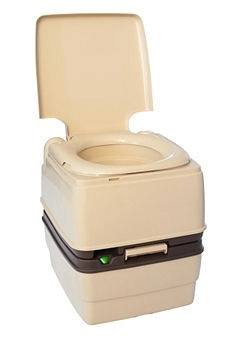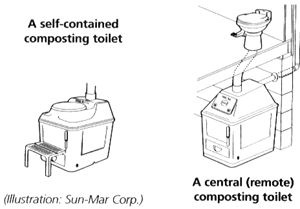Composting Toilets
What is a composting toilet?
A composting toilet, also known as a dry toilet or waterless toilet, collects liquid and solid human waste and processes it into compost (fertilizer) which can be used for landscaping or disposed of at a wastewater treatment plant. This is what differentiates a composting toilet from a traditional outhouse, which is simply a protective structure built over a hole or pit. The improper installation and use of a composting toilet may negatively impact public health. Additionally, please note that improper handling and use of compost may have serious public health consequences.
While some composting toilets may use small amounts of foam or water for waste conveyance, in general, composting toilets do not require connections to water or wastewater infrastructure. If foam is used, it is generally a biodegradable soap that serves the purpose of improving user comfort, cleaning, and waste conveyance. Additionally, bulking agents such as sawdust or leaves are sometimes added to solid waste to help the composting process.
Composting toilets are also sometimes called biological toilets, foam-flush toilets, or sewer-less toilets.
Are there different types of composting toilets?

There are numerous composting toilet brands on the market that vary widely in system design, cost, and maintenance requirements. In fact, there are more choices for composting toilets than conventional toilets. Composting toilets are required to have a toilet seat as well as continuous ventilation to avoid any odor issues. Composting toilets are typically made of plastic, ceramic, or fiberglass, and generally have two primary components – the toilet and the composting tank. The composting tank often includes a fan to help manage odor.
While all composting toilets function in virtually the same manner, cost and maintenance requirements vary widely from product-to-product. Certain models require electricity and automated fans to function, while others are passive and do not require electricity. Many products use solar panels to provide the electricity.
An important distinction is the difference between self-contained and centralized systems. Self-contained systems are sold as a single-unit and are generally used in rural, single family residential applications as they cannot process large volumes of waste.

In a centralized system (also known as a remote system), the toilet connects to a composting tank that is usually located below grade. Centralized systems can process more waste than self-contained systems and are generally installed in remote areas for hikers and campers.
When selecting a composting toilet model, it is critical to select a model that is appropriately sized to meet the demands of the anticipated number of people per day. NSF/ANSI Standard 41 certifies composting toilets and similar treatment systems for public health protection and safety in regard to liquid containment, odors, and solid end products. The standard requires a minimum of six months of performance testing, which includes design loading and stress testing appropriate to three product classes: residential, cottage, or day-use park. There are many certified composting toilet models available for purchase.
What are the maintenance requirements?
In addition to proper installation, the proper maintenance of composting toilets is critical to ensure ongoing safe operation and the avoidance of health hazards and odors. Maintenance requirements vary from system to system – understanding the maintenance requirements and schedule of your composting toilet is essential. Many companies offer maintenance services by trained and licensed professionals. Please consult with the vendor of your composting toilet to fully understand the maintenance requirements.
Maintenance for the composting toilet will be driven by the amount of daily use and the model of toilet selected. Some general maintenance requirements of composting toilets include:
- Toilet and bathroom cleaning – be sure to use cleaning agents that will not negatively affect the composting process.
- Periodic mixing of compost
- Adding organic bulking agents, such as leaves or sawdust
- Removing the finished end-product (compost or fertilizer).
The compost may be put to beneficial use for landscaping or disposed of at a waste water treatment plan. In San Francisco, the waste must be hauled and discharged by a California State licensed waste hauler that has a permit from the San Francisco Public Utilities Commission Wastewater Enterprise to discharge at one of San Francisco’s wastewater treatment plants.
Where are composting toilets typically installed?
Composting toilets are well suited for rural areas or locations where water and/or sewer facilities are not available. They are installed in national parks, golf courses, and roadside facilities in both the United States and internationally and often found in regions of the world with severe water shortages. While rare, composting toilets have also been installed in urban areas as demonstration projects.
How can I install a Composting Toilet in San Francisco?
If your project is in an area without water or sewer facilities, a composting toilet may be a good option. As with other types of plumbing fixtures, the San Francisco Department of Building Inspection’s (DBI) Plumbing Inspection Division has jurisdiction over the installation of compostable toilets in San Francisco. You will be required to obtain any permits required by the Department of Building Inspection or other city departments, as applicable. DBI may seek advice from the San Francisco Department of Public Health (SFDPH) when a compostable toilet installation could have broader implications for the public’s health, such as in parks, non-residential or other public settings. SFDPH does not have any ongoing oversight or reporting requirements for these toilets; however, SFDPH has an interest in understanding how this technology performs, and will keep a record of composting toilet installations. If you have any questions about installing a composting toilet, please contact Nonpotable@sfwater.org.

